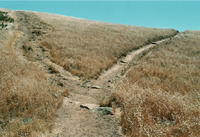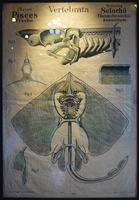Items
Site
The Medicine Chest
keywords is exactly
categories
-

Door, 11 rue Larrey, New York.
-

A1.44.
The contents of Floyd’s two travelling cases for his hunting trip (BC666 A1.44. Special Collections, University of Cape Town). -

Or
"The processes of digression and diversion have much in common with what the writer Ross Chambers (1999) calls ‘loiterature’. Chambers investigates the digressive, category-blurring genre of writing found in works such as Nicholson Baker’s 'The mezzanine', Paul Auster’s 'City of glass' and Laurence Sterne’s 'Tristam Shandy'. Loiterly writing, according to Chambers, disarms criticism by providing a moving target, shifting as its own divided attention constantly shifts. Criticism depends on the opportunity to discriminate and hierarchise, determining what is central and what is peripheral (Chambers 1999: 9), which this form eludes by resisting contextualisation or singular categorisation. Loiterature promotes sites of endless intersection, where attention is always divided between one thing and some other thing, always willing and able to be distracted, contrasting ‘the disciplined and the orderly, the hierarchical and the stable, the methodical and the systematic’ (Chambers 1999: 10). In contrast to methods of science that seek to stabilise objects within taxonomic systems or that require the formulation of hypotheses to provide direction for experimentation and a basis for concrete outcomes, the processes of curatorship and artmaking revel in rerouting and redirecting and in diversion and digression" (Liebenberg 2021: 286). -

'How Zoology was taught in the past'
The wall text accompanying these charts in the Hunterian museum, Glasgow, reads: "In the late 19th and 20th centuries, before the advent of colour slides that could be projected, the teaching of Zoology depended heavily on the use of wall charts to illustrate lectures. They were hung on a special pulley system at the front of the lecture theatre and, because of their large size, could be clearly seen from the back of the class". -

The Hunting of the Snark
"The Hunting of the Snark offers a timely caution for geographical investigation. The danger, both academic and pragmatic, of enslavement to static conceptual categories, rigid classifications, and established methodological procedures is simply that they tend to rule out the possibility of experiencing that insight and understanding which can be neither discovered, formulated nor communicated by adherence to traditional investigative methdologies. This is not to advocate an un-methodical and irrational geographical philosophy, but rather to suggest that there may be conditions under which slavish adherence to a tried and tested methodology may fail to provide reliable guidance in our search for understanding. A lack of commitment to open-ended investigation could mean that, because our methods are inappropriate, our explorations will forever remain, so to speak, 'snarked' ". -

Ocean Chart
"He had bought a large map representing the sea, Without the least vestige of land: And the crew were much pleased when they found it to be A map they could all understand". -

Pattern recognition
A display in Groote Schuur Hospital, Cape Town. The label reads: The History of Crockery Apartheid did more than separate the races. Parallel with the separate crockery for the different religions (Jewish = Blue; Muslim = Pink) was a range of separate crockery for the staff and patients of different races. Here are a few examples of this complex collection: Royal Blue: Jewish patients and staff (kosher) Dark Navy Blue: "European" patients Green: "European" staff Maroon: "Non European" patients Black: "Non European" staff Pink: Muslim patients and staff (halaal) These pieces of crockery are now part of our history and all patients are served meals in the standard rectangular crocker plate. -

Avoided Object
Photographs of the sky above the Imperial War Museum taken with the camera that belonged to Hoess, commandant of Auschwitz -

Scientific atlases
"Used from the 18th to the 20th centuries, the scientific atlases provided, for example, simplified, generalised and idealised versions of the objects of anatomy, physiology, botany, palaeontology and astronomy, to name a few, guiding the student and practitioner to what was worth looking at, how it looked and, perhaps most important of all, how it should be looked at (Daston & Galison 2007:23). The establishment and representations of these working sets of objects, and the standardised procedures for studying them, thus extended the initial influence exercised on the individual traveller in the field. By controlling the very act of seeing and by creating a sense of individuals working as members of academic communities, the atlases shaped the subjects and the objects of their disciplines. Processes initiated in the field and reinforced in institutions, societies and museums laid the foundation for procedures still used by the disciplinary insiders of university departments today" (Liebenberg 2021: 111).


